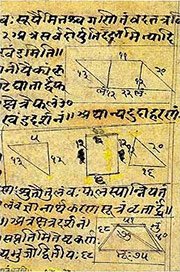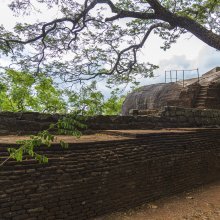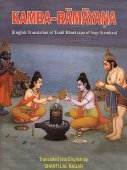Shaila, Śaila: 23 definitions
Introduction:
Shaila means something in Buddhism, Pali, Hinduism, Sanskrit, Jainism, Prakrit, the history of ancient India, Marathi, Hindi. If you want to know the exact meaning, history, etymology or English translation of this term then check out the descriptions on this page. Add your comment or reference to a book if you want to contribute to this summary article.
The Sanskrit term Śaila can be transliterated into English as Saila or Shaila, using the IAST transliteration scheme (?).
Alternative spellings of this word include Shale.
Images (photo gallery)
In Hinduism
Ayurveda (science of life)
Nighantu (Synonyms and Characteristics of Drugs and technical terms)
Source: Wisdom Library: Raj NighantuŚaila (शैल) refers to “mountain” and is mentioned together with a list of 24 synonyms for the word “mountain” according to the second chapter (dharaṇyādi-varga) of the 13th-century Raj Nighantu or Rājanighaṇṭu (an Ayurvedic encyclopedia). The Dharaṇyādi-varga covers the lands, soil, mountains [viz., Śaila], jungles and vegetation’s relations between trees and plants and substances, with their various kinds.
The following synonyms for mountain (śaila) are mentioned:
- Giri,
- Dharaṇīdhra,
- Gotrā,
- Bhūbhṛt,
- Śikhari,
- Śiloccaya,
- Sānumān,
- Kṣitibhṛt,
- Aga,
- Naga,
- Avanīdhara,
- Adri,
- Sthira,
- Kudhara,
- Dharādhara,
- Dhara,
- Ahārya,
- Parvata,
- Grāvā,
- Kaṭakī,
- Prasthavān,
- Śṛṅgī,
- Vṛkṣavān,
Unclassified Ayurveda definitions
Source: archive.org: Vagbhata’s Ashtanga Hridaya Samhita (first 5 chapters)Śaila (शैल) refers to “(water from) rocks”, as mentioned in verse 5.13-14 of the Aṣṭāṅgahṛdayasaṃhitā (Sūtrasthāna) by Vāgbhaṭa.—Accordingly, “[...] as concerns (water from) wells, ponds [viz., śaila: jāṅgalānūpaśailataḥ], etc., one should know (if it comes) from jungle, swamp, or rock. No water or, in case of incapability, little (is) to be drunk by those suffering from weak digestion and visceral induration (and) by those suffering from jaundice, abdominal swellings, diarrhea, hemorrhoids, dysentery, and cutaneous swellings. Except in autumn and summer, even a healthy man shall drink only little”.

Āyurveda (आयुर्वेद, ayurveda) is a branch of Indian science dealing with medicine, herbalism, taxology, anatomy, surgery, alchemy and related topics. Traditional practice of Āyurveda in ancient India dates back to at least the first millenium BC. Literature is commonly written in Sanskrit using various poetic metres.
Shaktism (Shakta philosophy)
Source: Google Books: ManthanabhairavatantramŚaila (शैल) refers to “mountains”, according to the Ṣaṭsāhasrasaṃhitā, an expansion of the Kubjikāmatatantra: the earliest popular and most authoritative Tantra of the Kubjikā cult.—Accordingly, “The venerable great lord of Oḍra resides in the cavity in the Middle Land. It is (Oḍḍiyāna) the first (sacred seat) and, yellow in colour, it has mountains, forests, and groves [i.e., sa-śaila-vana-kānana], large and small, and is adorned with golden walls. It has rivers and rivulets and many (other) things. It is full of all the seeds and is square all around. It has thunderbolts as door chains and Mālinī (who resides there) holds a thunderbolt (vajra) in her hand. Endowed with the sovereignty of the Wheels, it is the sacred seat (Udyāna) attended by the mistress of the sacred seat”.

Shakta (शाक्त, śākta) or Shaktism (śāktism) represents a tradition of Hinduism where the Goddess (Devi) is revered and worshipped. Shakta literature includes a range of scriptures, including various Agamas and Tantras, although its roots may be traced back to the Vedas.
Jyotisha (astronomy and astrology)
Source: Wisdom Library: Brihat Samhita by VarahamihiraŚaila (शैल) refers to “mountains”, according to the Bṛhatsaṃhitā (chapter 4), an encyclopedic Sanskrit work written by Varāhamihira mainly focusing on the science of ancient Indian astronomy astronomy (Jyotiṣa).—Accordingly, “If Jupiter should be eclipsed by the lunar disc the men of Gāndhāra, of Sauvīraka, of Sindhu and of Kīra (Kāśmīra) the rulers of the Draviḍa countries and Brāhmins as well as food grains and mountains [i.e., śaila] will suffer for ten months. If Mars should be so eclipsed the rulers of Traigarta (Lāhora) and of Mālavā, with their fighting men in their cars, the chiefs of Kulinda, the rulers of Śibi, of Audha, of Kuru (Delhi), of Matsya and of Śukti will suffer for six months”.

Jyotisha (ज्योतिष, jyotiṣa or jyotish) refers to ‘astronomy’ or “Vedic astrology” and represents the fifth of the six Vedangas (additional sciences to be studied along with the Vedas). Jyotisha concerns itself with the study and prediction of the movements of celestial bodies, in order to calculate the auspicious time for rituals and ceremonies.
Vaishnavism (Vaishava dharma)
Source: Brill: Śaivism and the Tantric Traditions (vaishnavism)Śaila (शैल) refers to the “mountain” (from which originate all the streams of knowledge), according to the Vedānta Deśika’s Yatirājasaptati.—When we come to the poem’s understanding of the divinity of Rāmānuja we find a wide spectrum of meanings. [...] Verse 28 is particularly eloquent in describing and encapsulating all his nurturing and protecting qualities, which are compared to those present everywhere in nature itself—as the mountain (śaila) from which originate all the streams of knowledge, the tree under which the weary traveler wandering in saṃsāra takes rest, the rising sun that keeps the illusionary darkness of those with distorted views at bay and the full moon that brings to high tide the ocean of the Vedas.

Vaishnava (वैष्णव, vaiṣṇava) or vaishnavism (vaiṣṇavism) represents a tradition of Hinduism worshipping Vishnu as the supreme Lord. Similar to the Shaktism and Shaivism traditions, Vaishnavism also developed as an individual movement, famous for its exposition of the dashavatara (‘ten avatars of Vishnu’).
Ganitashastra (Mathematics and Algebra)
Source: archive.org: Hindu MathematicsŚaila (शैल) represents the number 7 (seven) in the “word-numeral system” (bhūtasaṃkhyā), which was used in Sanskrit texts dealing with astronomy, mathematics, metrics, as well as in the dates of inscriptions and manuscripts in ancient Indian literature.—A system of expressing numbers by means of words arranged as in the place-value notation was developed and perfected in India in the early centuries of the Christian era. In this system the numerals [e.g., 7—śaila] are expressed by names of things, beings or concepts, which, naturally or in accordance with the teaching of the Śāstras, connote numbers.

Ganitashastra (शिल्पशास्त्र, gaṇitaśāstra) refers to the ancient Indian science of mathematics, algebra, number theory, arithmetic, etc. Closely allied with astronomy, both were commonly taught and studied in universities, even since the 1st millennium BCE. Ganita-shastra also includes ritualistic math-books such as the Shulba-sutras.
Purana and Itihasa (epic history)
Source: archive.org: Shiva Purana - English TranslationŚaila (शैल) refers to the “mountains” (such as Himavat, etc.), according to the Śivapurāṇa 2.5.2 (“The Prayer of the gods).—Accordingly, as the Gods eulogized Śiva: “[...] Among all stones, you are the crystal, O great god, among the flowers you are the lotus; among mountains (śaila) you are Himavat. Among all activities you are the speech; among poets you are Bhārgava. Among birds you are the eight-legged Śarabha. Among beasts of prey you are the lion. [...]”.

The Purana (पुराण, purāṇas) refers to Sanskrit literature preserving ancient India’s vast cultural history, including historical legends, religious ceremonies, various arts and sciences. The eighteen mahapuranas total over 400,000 shlokas (metrical couplets) and date to at least several centuries BCE.
In Buddhism
Mahayana (major branch of Buddhism)
Source: Wisdom Library: Maha Prajnaparamita Sastra1) Śaila (शैल) refers to “stone (begging bowl)”, according to Mahāprajñāpāramitāśāstra (chapter 41).—Accordingly, “[Digression on a case brought against the Buddha; A. The accusation].—[Question].—So be it! But the Buddha sometimes has physical and vocal actions that do not seem to accompany knowledge. How is that? [...] He insults his disciples and treats them like foolish men (mohapuruṣa). He insults Devadatta and says to him: ‘You are a fool (mūḍha), a corpse (śava), a spit-swallower (kheṭāśika)’. The Buddha forbids the possession (dhāraṇa) of eight kinds of begging-bowls (pātra) and authorizes the Bhikṣus to use only two kinds of bowls: i) fired clay (mṛttikāpātra) and ii) iron (ayaḥpātra) but he himself uses a stone bowl (śaila-pātra). [...]”.
2) Śaila (शैल) is the name of a Brāhmaṇa, according to the 2nd century Mahāprajñāpāramitāśāstra chapter 52.—Accordingly, “[...] Also, the Brāhmaṇa Che-yi-lo (Śaila) first heard the name of ‘Buddha’ at the home of the Jaṭila-Brahmacārin Ki-ni-ye (Keṇiya); his mind was overjoyed; he went straight to the Buddha; he heard the Dharma and obtained bodhi”.
Note: The conversion of Śaila (in Pāli, Sela) is told, partially in the same words, by the Selasutta of the Suttanipāta and of the Majjhima.—See also the Tseng yi a han.

Mahayana (महायान, mahāyāna) is a major branch of Buddhism focusing on the path of a Bodhisattva (spiritual aspirants/ enlightened beings). Extant literature is vast and primarely composed in the Sanskrit language. There are many sūtras of which some of the earliest are the various Prajñāpāramitā sūtras.
In Jainism
General definition (in Jainism)
Source: The University of Sydney: A study of the Twelve ReflectionsŚaila (शैल) refers to “mountains”, according to the 11th century Jñānārṇava, a treatise on Jain Yoga in roughly 2200 Sanskrit verses composed by Śubhacandra.—Accordingly, “This world totters to the limit of the world of Brahmā with the fear of the beginning of a frown, and mountains (śaila) immediately fall asunder by force of [the fact that] the earth is overcome by the weight of the heavy feet, of those heroes who are all led to death by the king of time in [the space of] some days. Nevertheless, desire is intense only in a living being who is bereft of sense”.
Synonyms: Parvata.

Jainism is an Indian religion of Dharma whose doctrine revolves around harmlessness (ahimsa) towards every living being. The two major branches (Digambara and Svetambara) of Jainism stimulate self-control (or, shramana, ‘self-reliance’) and spiritual development through a path of peace for the soul to progess to the ultimate goal.
India history and geography
Source: Cologne Digital Sanskrit Dictionaries: Indian Epigraphical GlossaryŚaila.—(IE 7-1-2; EI 25), ‘seven’. Note: śaila is defined in the “Indian epigraphical glossary” as it can be found on ancient inscriptions commonly written in Sanskrit, Prakrit or Dravidian languages.

The history of India traces the identification of countries, villages, towns and other regions of India, as well as mythology, zoology, royal dynasties, rulers, tribes, local festivities and traditions and regional languages. Ancient India enjoyed religious freedom and encourages the path of Dharma, a concept common to Buddhism, Hinduism, and Jainism.
Languages of India and abroad
Marathi-English dictionary
Source: DDSA: The Molesworth Marathi and English Dictionaryśaila (शैल).—m S corruptly śailya m A mountain.
--- OR ---
śaila (शैल).—a S Mountainous, relating to a mountain.
--- OR ---
saīla (सईल).—&c. See under saila.
--- OR ---
sāilā (साइला).—m C and Local--Jungle animals or an animal killed or captured (and brought to the idol-house to be killed) at the hunting of the village-god. Ex. gāṃvānta dēvaskīcā sāilā paḍēla tyācē pharē khōtāsa yētāta.
--- OR ---
sāīla (साईल).—m C See sāilā.
--- OR ---
saila (सैल).—f The dāṇḍā in which kaṅgaṇī and similar ornaments are fashioned.
--- OR ---
saila (सैल).—a (śithila S) Slack, loose, lax, flaccid; not tight, not firm, not compact. saila sōḍaṇēṃ To let loose; to let run with slack rein or under slack hand; as mūla saila sōḍalā mūrkha jhālā.
Source: DDSA: The Aryabhusan school dictionary, Marathi-Englishśaila (शैल).—m A mountain. a Mountainous.
--- OR ---
saila (सैल).—a Loose, slack; not tight. saila sōḍaṇēṃ Let loose.
Marathi is an Indo-European language having over 70 million native speakers people in (predominantly) Maharashtra India. Marathi, like many other Indo-Aryan languages, evolved from early forms of Prakrit, which itself is a subset of Sanskrit, one of the most ancient languages of the world.
Sanskrit dictionary
Source: DDSA: The practical Sanskrit-English dictionaryŚaila (शैल).—a. (-lī f.) [शिलाः सन्त्यस्य प्रज्ञा° अण् (śilāḥ santyasya prajñā° aṇ)] Rocky, craggy, stony; शैलनीव च दृश्यन्ते (śailanīva ca dṛśyante) Mahābhārata (Bombay) 5.1.11; शैली दारुमयी लौही (śailī dārumayī lauhī)... प्रतिमाष्टविधा स्मृता (pratimāṣṭavidhā smṛtā) Bhāgavata 11.27.12.
2) Stone-like, rigid.
-laḥ 1 A mountain, hill; शैले शैले न मणिक्यं मौक्तिकं न गजे गजे (śaile śaile na maṇikyaṃ mauktikaṃ na gaje gaje) Chāṇ.55; शैलौ मलयदुर्दुरौ (śailau malayadurdurau) R.4.51.
2) A dike, dam.
3) A rock, big stone.
-lam 1 Borax, benzoin.
2) Bitumen.
3) A kind of collyrium.
4) A heap of stones; तेनाभि- पतिता दावं शैलेन महता भृशम् (tenābhi- patitā dāvaṃ śailena mahatā bhṛśam) Mahābhārata (Bombay) 1.227.52.
Source: Cologne Digital Sanskrit Dictionaries: Edgerton Buddhist Hybrid Sanskrit DictionaryŚaila (शैल).—(see also Śela, Saila, and Pūrva-śaila, Apa- ra-ś°), name of a brahmanical ascetic (ṛṣi), Kaineya's sister's son: Mūla-Sarvāstivāda-Vinaya i.264.3 ff.
--- OR ---
Śailā (शैला).—(= Pali Selā), name of an important nun, follower of Śākyamuni: Divyāvadāna 552.18 ff.; 573.8 ff.
--- OR ---
Saila (सैल).—(read Śaila?), name of a yakṣa: Mahā-Māyūrī 2.
Source: Cologne Digital Sanskrit Dictionaries: Shabda-Sagara Sanskrit-English DictionaryŚaila (शैल).—mfn.
(-laḥ-lī-laṃ) 1. Mountainous, mountaineer, &c. 2. Stony, rocky. m.
(-laḥ) A mountain. n.
(-laṃ) 1. Bitumen. 2. Storax. 3. A sort of collyrium: see rasāñjana. f. (-lī) 1. A concise interpretation of a grammatical aphorism. 2. A mode of interpretation. 3. Course, conduct. E. śilā a rock, a stone, aṇ aff.
Source: Cologne Digital Sanskrit Dictionaries: Benfey Sanskrit-English DictionaryŚaila (शैल).—i. e. śilā + a, I. adj. 1. Stony, [Arjunasamāgama] 8, 10; rocky. 2. Mountainous, mountaineer. Ii. m. 1. A mountain, [Mānavadharmaśāstra] 1, 27; [Vikramorvaśī, (ed. Bollensen.)] 10, 6. 2. A dike, [Pañcatantra] i. [distich] 115. Iii. n. 1. Bitumen. 2. Storax.
Source: Cologne Digital Sanskrit Dictionaries: Cappeller Sanskrit-English DictionaryŚaila (शैल).—[feminine] ī stony, stone-like; [masculine] (adj. —° [feminine] ā) rock, mountain, [abstract] tā [feminine], tva [neuter]
Source: Cologne Digital Sanskrit Dictionaries: Monier-Williams Sanskrit-English Dictionary1) Śaila (शैल):—mf(ī)n. ([from] śilā) made of stone, stony, rocky, [Mahābhārata; Harivaṃśa] etc.
2) stone-like, rigid (with āsana n. a [particular] manner of sitting), [Catalogue(s)]
3) m. (ifc. f(ā). ) a rock, crag, hill, mountain (there are seven [or, [according to] to some, eight] mythical mountain ranges separating the divisions of the earth, viz. niṣadha, hema-kūṭa, nīla, śveta, śṛṅgin, mālyavat, gandha-mādana, [Viṣṇu-purāṇa]), [Manu-smṛti; Mahābhārata] etc.
4) m. Name of the number ‘seven’ [Gaṇitādhyāya]
5) a dike, [Monier-Williams’ Sanskrit-English Dictionary]
6) Śailā (शैला):—[from śaila] f. Name of a nun, [Divyāvadāna]
7) Śaila (शैल):—n. (only [cf. Lexicographers, esp. such as amarasiṃha, halāyudha, hemacandra, etc.]) benzoin or storax
8) bitumen
9) a sort of collyrium.
Source: Cologne Digital Sanskrit Dictionaries: Yates Sanskrit-English DictionaryŚaila (शैल):—[(laḥ-lī-laṃ) m.] A mountain. n. Bitumen, storax, collyrium. f. (ī) Concise interpretation of a grammatical aphorism. a. Stony, mountainous.
Source: DDSA: Paia-sadda-mahannavo; a comprehensive Prakrit Hindi dictionary (S)Śaila (शैल) in the Sanskrit language is related to the Prakrit words: Sela, Selā.
[Sanskrit to German]
Sanskrit, also spelled संस्कृतम् (saṃskṛtam), is an ancient language of India commonly seen as the grandmother of the Indo-European language family (even English!). Closely allied with Prakrit and Pali, Sanskrit is more exhaustive in both grammar and terms and has the most extensive collection of literature in the world, greatly surpassing its sister-languages Greek and Latin.
Hindi dictionary
Source: DDSA: A practical Hindi-English dictionaryŚaila (शैल) [Also spelled shale]:—(nm) a rock; hill, mountain; ~[rāja] the Himalayas; -[saṃdhi] a valley; pass.
...
Kannada-English dictionary
Source: Alar: Kannada-English corpusŚaila (ಶೈಲ):—
1) [adjective] made of stone; stony; rocky.
2) [adjective] stone-like; rigid.
3) [adjective] lacking feeling; unfeeling.
--- OR ---
Śaila (ಶೈಲ):—
1) [noun] a large mass of stone; a rock.
2) [noun] a mountain (made chiefly of rocks).
3) [noun] (math.) a symbol for the number seven.
4) [noun] (vīr.) a particular kind of token, worn by a pontiff assuming the office of the head of a Vīraśaiva monastery.
--- OR ---
Śaiḷa (ಶೈಳ):—[adjective] = ಶೈಲ [shaila]1.
--- OR ---
Śaiḷa (ಶೈಳ):—[noun] = ಶೈಲ [shaila]2.
--- OR ---
Saila (ಸೈಲ):—[noun] = ಸೈಲು [sailu].
Kannada is a Dravidian language (as opposed to the Indo-European language family) mainly spoken in the southwestern region of India.
See also (Relevant definitions)
Starts with (+135): Shaila-devagriha, Shaila-griha, Shaila-karman, Shaila-rupakarman, Shaila-vardhakin, Shailabahu, Shailabha, Shailabhadra, Shailabhana, Shailabheda, Shailabhitti, Shailabija, Shailacapa, Shailacarya, Shailacitta, Shailada, Shailadhanvan, Shailadhara, Shailadhatu, Shailadhatuja.
Ends with (+66): Ambarashaila, Aparashaila, Ashaila, Astashaila, Avarashaila, Badarishaila, Bhadrashaila, Caitya-shaila, Caityaka-shaila, Catuhshaila, Chatuhshaila, Dhanyashaila, Dharanidharashaila, Durgashaila, Gajashaila, Gandashaila, Gandhashaila, Ghritashaila, Haimashaila, Hemashaila.
Full-text (+312): Tarkshyashaila, Gandashaila, Shailam, Shailaniryasa, Shailakataka, Purvashaila, Shailasara, Padashaila, Shailata, Badarishaila, Shailapati, Shrishaila, Shailaja, Caitika, Shailagra, Shailajana, Shailasetu, Shailadhiraja, Shailadhanvan, Sela.
Relevant text
Search found 63 books and stories containing Shaila, Śaila, Saila, Saīla, Sāilā, Sāīla, Śailā, Śaiḷa; (plurals include: Shailas, Śailas, Sailas, Saīlas, Sāilās, Sāīlas, Śailās, Śaiḷas). You can also click to the full overview containing English textual excerpts. Below are direct links for the most relevant articles:
Garga Samhita (English) (by Danavir Goswami)
Verse 6.14.35 < [Chapter 14 - The Glories of Ratnākara, Raivata, and Kācala]
Verse 2.3.11 < [Chapter 3 - Description of the Yamunā’s Arrival]
Verses 6.14.19-20 < [Chapter 14 - The Glories of Ratnākara, Raivata, and Kācala]
Hari-bhakti-kalpa-latikā (by Sarasvati Thkura)
Text 47 < [Second Stabaka]
Amarakoshodghatana of Kshirasvamin (study) (by A. Yamuna Devi)
Earth and its aspects < [Chapter 5 - Aspects of Nature]
Amarakośa of Amarasiṃha < [Chapter 1 - Kośa Literature–A Brief Survey]
The Agni Purana (by N. Gangadharan)
Chapter 140 - Description of herbs used in charms
Chapter 141 - Description of herbs used in charms, medicines etc.
Sahitya-kaumudi by Baladeva Vidyabhushana (by Gaurapada Dāsa)
Text 4.86 < [Chapter 4 - First-rate Poetry]
Text 10.204 < [Chapter 10 - Ornaments of Meaning]
Text 7.72 < [Chapter 7 - Literary Faults]
Siddhanta Sangraha of Sri Sailacharya (by E. Sowmya Narayanan)
Related products

